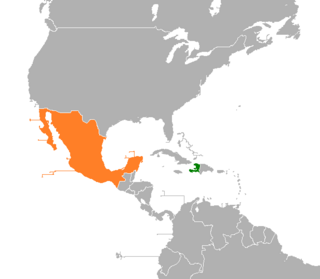
Port-au-Prince is the capital and most populous city of Haiti. The city's population was estimated at 987,311 in 2015 with the metropolitan area estimated at a population of 2,618,894. The metropolitan area is defined by the IHSI as including the communes of Port-au-Prince, Delmas, Cite Soleil, Tabarre, Carrefour and Pétion-Ville.

Cap-Haïtien, typically spelled Cape Haitien in English and often locally referred to as Le Cap or Au Cap, is a commune of about 190,000 people on the north coast of Haiti and capital of the department of Nord. Previously named Cap‑Français and Cap‑Henri during the rule of Henri I, it was historically nicknamed the Paris of the Antilles, because of its wealth and sophistication, expressed through its architecture and artistic life. It was an important city during the colonial period, serving as the capital of the French Colony of Saint-Domingue from the city's formal foundation in 1711 until 1770 when the capital was moved to Port-au-Prince. After the Haitian Revolution, it became the capital of the Kingdom of Haiti under King Henri I until 1820.

Ouest (French) or Lwès is one of the ten departments of Haiti and located in Centre-Sud of the country linking the Great-North and the Tiburon Peninsula.

Jacmel is a commune in southern Haiti founded by the Spanish in 1504 and repopulated by the French in 1698. It is the capital of the department of Sud-Est, 24 miles southwest of Port-au-Prince across the Tiburon Peninsula, and has an estimated population of 40,000, while the commune of Jacmel had a population of 137,966 at the 2003 Census. The town's name is derived from its indigenous Taíno name of Yaquimel. In 1925, Jacmel was dubbed as the "City of Light," becoming the first in the Caribbean to have electricity.

The Cathedral of Our Lady of the Assumption, often called Port-au-Prince Cathedral, was a cathedral in Port-au-Prince, Haiti. Built between 1884 and 1914, it was dedicated on December 13, 1928, and became the cathedral church of the Roman Catholic Archdiocese of Port-au-Prince. The cathedral was destroyed in the 12 January 2010 earthquake.

Cité Soleil is an extremely impoverished and densely populated commune located in the Port-au-Prince metropolitan area in Haiti. Cité Soleil originally developed as a shanty town and grew to an estimated 200,000 to 400,000 residents, the majority of whom live in extreme poverty. The area is generally regarded as one of the poorest and most dangerous areas of the Western Hemisphere and it is one of the biggest slums in the Northern Hemisphere. The area has virtually no sewers and has a poorly maintained open canal system that serves as its sewage system, few formal businesses but many local commercial activities and enterprises, sporadic but largely unpaid for electricity, a few hospitals, and two government schools, Lycee Nationale de Cité Soleil, and Ecole Nationale de Cité Soleil. For several years until 2007, the area was ruled by a number of gangs, each controlling their own sectors. But government control was reestablished after a series of operations in early 2007 by the United Nations Stabilization Mission in Haiti (MINUSTAH) with the participation of the local population.

The National Assembly is the bicameral legislature of the Republic of Haiti, consisting of the upper house as the Senate (Sénat) and the lower house as the Chamber of Deputies. Both assemblies conduct legislative sessions at the Haitian capital of Port-au-Prince.
Croix-des-Bouquets is a commune in the Ouest department of Haiti. It is located 12.9 kilometers (8.0 mi) to the northeast of Haiti's capital city, Port-au-Prince. Originally located on the shore, it was relocated inland after the 1770 Port-au-Prince earthquake. Therefore, the town not as badly affected in the 2010 earthquake.

Pétion-Ville is a commune and a suburb of Port-au-Prince, Haiti, in the hills east and separate from the city itself on the northern hills of the Massif de la Selle. Founded in 1831 by president Jean-Pierre Boyer, it was named after Alexandre Sabès Pétion (1770–1818), the Haitian general and president later recognized as one of the country's four founding fathers.

The Episcopal Diocese of Haiti is the Anglican Communion diocese consisting of the entire territory of Haiti. It is part of Province 2 of the Episcopal Church in the United States of America. Its cathedral, Holy Trinity located in the corner of Ave. Mgr. Guilloux & Rue Pavée in downtown Port-au-Prince, has been destroyed six times, including in the 2010 Haiti earthquake.

Jean Jimmy Alexandre, better known by his stage name Jimmy O, was a Haitian hip hop artist who was born in Port-au-Prince and lived in New York City. He was involved with Wyclef Jean's Yéle Haiti Foundation. Jimmy O performed his music in Haitian Creole.

Georges Anglade was a Haitian–Canadian geographer, professor, writer and politician.

A catastrophic magnitude 7.0 Mw earthquake struck Haiti at 16:53 local time on Tuesday, 12 January 2010. The epicenter was near the town of Léogâne, Ouest department, approximately 25 kilometres (16 mi) west of Port-au-Prince, Haiti's capital.

Casualties of the 2010 Haiti earthquake include both civilian and government officials, locals and foreigners – however the overwhelming majority of those killed and wounded in the quake were Haitian civilians. A number of public figures died in the earthquake, including government officials, clergy members, musicians, together with foreign civilian and military personnel working with the United Nations. On 15 January, the Red Cross estimated the death toll at between 45,000 and 50,000, however by 24 January, Communications Minister Marie-Laurence Jocelyn Lassegue said the death toll was over 150,000 in the Port-au-Prince metropolitan area alone. Haitian president René Préval reported on 27 January that "nearly 170,000" bodies had been counted.
"Stranded " is a song recorded by Jay-Z, Bono, The Edge and Rihanna for Hope for Haiti Now, a live album by various artists to benefit the campaign of the same name to alleviate the 2010 Haiti earthquake. The song was written by Jay-Z, The Edge and Bono and produced by Swizz Beatz.

Damage to infrastructure in the 2010 Haiti earthquake was extensive and affected areas included Port-au-Prince, Petit-Goâve, Léogâne, Jacmel and other settlements in southwestern Haiti. In February Prime Minister Jean-Max Bellerive estimated that 250,000 residences and 30,000 commercial buildings had collapsed or were severely damaged. The deputy mayor of Léogâne, which was at the epicenter of the earthquake, reported that 90% percent of the buildings in that city had been destroyed and Léogâne had "to be totally rebuilt." Many notable landmark buildings were significantly damaged or destroyed, including the Presidential Palace, the National Assembly building, the Port-au-Prince Cathedral, and the main jail. The Ministry of Education estimated that half the nation's 15,000 primary schools and 1,500 secondary schools were severely damaged, cracked or destroyed. In addition, the three main universities in Port-au-Prince were also severely damaged. Other affected infrastructure included telephone networks, radio station, factories, and museums. Poor infrastructure before the earthquake only made the aftermath worse. It would take half a day to make a trip of a few miles. The roads would also crisscross haphazardly due to disorganized construction.
The following is a timeline of the history of the city of Port-au-Prince, Haiti.

Haiti–Mexico relations are the diplomatic relations between Haiti and Mexico. Both nations are members of Association of Caribbean States, Community of Latin American and Caribbean States, Organization of American States and the United Nations.















